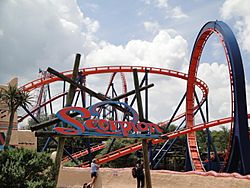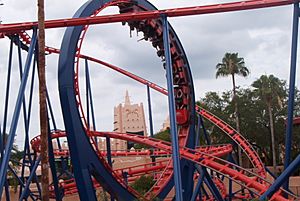Scorpion (roller coaster) facts for kids
Quick facts for kids Scorpion |
|
|---|---|

Scorpion seen within the Timbuktu section with SheiKra in the background
|
|
| Busch Gardens Tampa Bay | |
| Park section | Pantopia |
| Coordinates | 28°02′15″N 82°25′24″W / 28.03750°N 82.42333°W |
| Status | Operating |
| Opening date | May 16, 1980 |
| Cost | US$2.5 million – US$3 million |
| General statistics | |
| Type | Steel |
| Manufacturer | Anton Schwarzkopf |
| Designer | Werner Stengel |
| Model | Silver Arrow |
| Lift/launch system | Chain lift hill |
| Height | 60.7 ft (18.5 m) |
| Length | 1,817.6 ft (554.0 m) |
| Speed | 41 mph (66 km/h) |
| Inversions | 1 |
| Duration | 1:30 |
| G-force | 3.5 |
| Height restriction | 42 in (107 cm) |
| Trains | 2 trains with 5 cars. Riders are arranged 2 across in 2 rows for a total of 20 riders per train. |
| Scorpion at RCDB Pictures of Scorpion at RCDB |
|
Scorpion is a steel roller coaster at Busch Gardens Tampa Bay in Tampa, Florida. Built by Anton Schwarzkopf and designed by Werner Stengel, it opened on May 16, 1980, as the second roller coaster at the park. The roller coaster was added as part of the newly constructed Timbuktu section during the second-phased opening, being surrounded by the Congo and Nairobi sections. The roller coaster reaches a maximum height of 60.7 feet (18.5 m), with a maximum speed of 41 miles per hour (66 km/h), and a total length of 1,817.6 feet (554.0 m).
Scorpion is one of three Silver Arrow models produced by Anton Schwarzkopf, being the only one supported on a permanent structure. Upon opening, the roller coaster received generally positive reviews and with the closure of Python in 2006, Scorpion became the oldest roller coaster at Busch Gardens Tampa Bay.
History
Soon after the expansion of the Congo section of the park, which saw the opening of Python in the 1976 season, it was announced on May 9, 1978, by Anheuser-Busch (the initial owner of Busch Gardens Tampa) that another expansion would come to the park. The expansion was reported to begin soon after its approval, with site preparation to take place first, and cost between $5 million to $10 million. Construction of the area entitled "Timbuktu" that would encompass the latter roller coaster was observed by The Tampa Tribune in November 1978.
Anheuser-Busch announced a $12.3 million expansion to its Busch Garden Tampa park for a new section named Timbuktu on February 5, 1979. The 7-acre (2.8 ha) addition would see the construction of several attractions, including a roller coaster entitled "Scorpion" which was described as "a European designed roller coaster with a 360-degree-loop". The Timbuktu expansion would open in two phases, with the Scorpion roller coaster to open as part of the latter-half at a later date. The original opening date was reported to be in December 1979, though, was moved back several times.
The Timbuktu section of the park opened to guests on January 25, 1980. Construction of Scorpion was observed by the Orlando Sentinel in March 1980, with an opening that was due in May 1980. On May 16, 1980, Scorpion opened as the park's second roller coaster. In 2004, the Scorpion was repainted from its original paint scheme of orange track and black supports to red track with blue supports (a paint scheme similar to SheiKra). The roller coaster is now situated in the Pantopia section of the park, which was introduced to replace the Timbuktu section with the opening of the park's drop-tower, Falcon's Fury.
Ride experience
The train exits the station forward and ascends the 60.7 feet (18.5 m) lift hill. Once at the top, the train makes a slight right turn before descending into a banked drop reaching its maximum speed of 41 miles per hour (66 km/h). Following the drop, the trains enter the roller coaster's signature 39.3 foot (12.0 m) vertical loop before exiting into a banked left turn and ascends a hill. After cresting the ascent, the trains continue left into a banked drop in its sustained turn before straightening out and ascending into a small hill going through the vertical loop. After it traverses through the middle of the loop, the train then enters a continuous series of downward spiraling helixes banked to the right before exiting and straightening out into the final brake run. The train then travels forward into a right turn on the outside of the layout, going into straight track before making another right turn into the station. One cycle of the roller coaster takes about a minute and a half to complete.
Characteristics
The roller coaster was manufactured by Anton Schwarzkopf and designed by Werner Stengel. The total cost of construction for the roller coaster ranged from $2.5 million to $3 million. Scorpion was one of three Silver Arrow model roller coasters that were produced by Schwarzkopf, which includes Big Blue located at Fun Park Biograd in Biograd na Moru, Croatia, and the other known as Looping Star owned by the Rand Show in Johannesburg, South Africa. Scorpion has a permanent support structure, as opposed to the other Silver Arrow models being portable units.
Scorpion's track reaches a total length of 1,817.6 feet (554.0 m), and is encompassed in a 93.5 foot (28.5 m) by 213.8 foot (65.2 m) area. Scorpion exerts a maximum of 3.5 g-forces to its riders, and is named after the general species of scorpion. The roller coaster initially featured six-car trains that operated the layout. Scorpion operates with two trains, with five cars per train, each car is arranged two-seats across in two rows allowing for a maximum capacity of twenty riders per train. Originally the trains featured a red and orange color scheme, with the current iteration featuring a red, orange, and yellow color scheme. The ride features a lap bar restraint, accompanied by a rider height restriction of 42 inches (110 cm).
Images for kids



